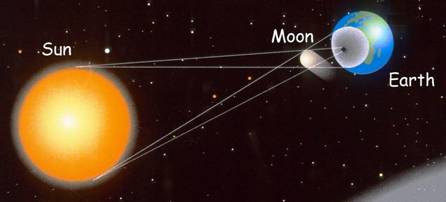|
The Greatest Spectacle in the Whole of Nature |

|
Why An Eclipse Happens |
|
It is a remarkable coincidence that the sun appears, from the earth, to be roughly as big as the moon. Actually it is 400 times bigger than the moon (and has 27 million times as much mass!) but as the moon is 400 times nearer to the earth, they both appear to be the same size in the sky. An eclipse of the sun, more usually called a solar eclipse, occurs when the moon passes directly between the sun and the earth so that all three bodies are lined up and the sun seems to disappear behind the moon. Essentially, the sun casts a shadow of the moon on the earth. When the earth is directly between the sun and the moon a lunar eclipse occurs. As the moon goes around the earth once every month, it may seem that a solar eclipse should also occur every month. Obviously, this doesn't happen - if it did then you wouldn't have the perfect excuse to trek all the way to the other side of the world to see one! The reason that this doesn't happen is that the plane of the moon's orbit around the earth is slightly tilted, by about 5°, with respect to the plane of the earth's orbit around the sun. So the moon usually passes a little above or below the sun when it is between the earth and the sun – this is the time of a new moon. There are one or two other factors, which we won't go into, that all conspire to make solar eclipses rare events. The moon actually goes around the earth in an elliptical, rather than a circular, orbit, so its distance from the earth varies and so does its apparent size. If an eclipse occurs when the moon is closer to the earth, the moon will appear relatively large and the shadow cast on the earth may be as much as 250 km across. Due to the motion of the moon, this shadow is drawn across the surface of the earth at very high speed, from one side to the other, basically from west to east, forming what is called the zone of totality (or umbra). Inside this relatively narrow zone an observer sees the sun completely covered by the moon, cutting off the light so that the corona, the sun’s outer atmosphere, can be seen directly.
As you go along this track, the duration peaks in the middle and as you go across the track, the duration also rises to a maximum and then decreases towards the other edge. Outside the zone is a much wider area where the three bodies are never exactly lined up and the sun is only partially eclipsed, therefore this is called the partial zone (penumbra). If, on the other hand, an eclipse occurs when the moon is furthest from the earth it may not appear big enough to completely cover the sun leaving a circle of sunlight, rather like a Polo mint, which is called an annular eclipse. These too are spectacular events, with their own special kind of excitement!
Back to Eclipse Home Page Forward to Some Background and a Little Bit of Jargon |
|
The Cloudfree Eclipse Company |
|
Home |
|
Why An Eclipse Happens |
|
Some Background |
|
Forthcoming Eclipses |
|
11 July 2010 |
|
20 May 2012 |
|
13 November 2012 |
|
Observing Safely |
|
Eclipse Consultants |
|
Eclipse Talks |
|
Contact Us |


